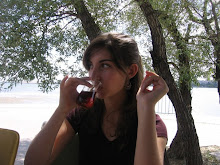
After six months of selling panini lunches, and smelling like burnt olive oil, we finally raised enough money to embark on our senior class trip to Costa Rica. We spent the first part of the trip near Monte Verde, in the cloud forests of San Luis. The service portion of our trip was done on a bio dynamic farm where we prepared beds, dug holes for coffee plants and spread coffee husk compost around coffee roots. The second portion of our trip was for relaxing; we stayed outside of Tamarindo in the hotel Las Tortugas which was located on the beach but also had its own pool and hot tub. Throughout the trip my classmates and I were introduced to the delicious traditional meals of Costa Rica, enriched with the fresh produce of Costa Rica's fertile agriculture.

We stopped for lunch after our arrival in San Jose at a restaurant literally translated as "The House of Corn." The avocados were ripened to perfection - a rare treat for us New Yorkers. The food was fresh and delicious; I could already tell this was going to be an unforgettable trip.
 This was my main course: chicken with sauteed peppers and onions, fresh salsa with tortillas, refried black beans and corn. Everything arrived on plates of plantain leaves. The homemade salsa was a fresh component to the meal with a sharp kick of cilantro. Many of us were surprised by the corn because, as Americans, we automatically expected the juicy American sweet corn that we are so accustomed to. The corn served at this "House of Corn" was not our familiar sweet corn but what we would call "cow corn" here (which is regularly served to cows in the US). This was not surprising to me because street vendors in Turkey market the same tough but flavorful corn in little trolleys at parks and street corners.
This was my main course: chicken with sauteed peppers and onions, fresh salsa with tortillas, refried black beans and corn. Everything arrived on plates of plantain leaves. The homemade salsa was a fresh component to the meal with a sharp kick of cilantro. Many of us were surprised by the corn because, as Americans, we automatically expected the juicy American sweet corn that we are so accustomed to. The corn served at this "House of Corn" was not our familiar sweet corn but what we would call "cow corn" here (which is regularly served to cows in the US). This was not surprising to me because street vendors in Turkey market the same tough but flavorful corn in little trolleys at parks and street corners.

For dessert, we were offered complimentary rice pudding which was flavored with a perfect blend of cinnamon and cardamom. The spiced pudding vaguely reminded me of Indian rice puddings but the spices were less potent and did not include the distinctive saffron.
 Before we arrived at our hotel, we also stopped by a small street-side shop which sold fresh fruit, dulce de leche candy and pastries as well as coconut water in small plastic bags. I bought a mango and was intoxicated by its delicious scent for the rest of the bus ride!
Before we arrived at our hotel, we also stopped by a small street-side shop which sold fresh fruit, dulce de leche candy and pastries as well as coconut water in small plastic bags. I bought a mango and was intoxicated by its delicious scent for the rest of the bus ride! Banana plants were a common sight amongst the tropical plants thriving on the biodynamic farm.
Banana plants were a common sight amongst the tropical plants thriving on the biodynamic farm. This photo was taken wit my classmate, Brogan O'Donnell's, superior camera.
This photo was taken wit my classmate, Brogan O'Donnell's, superior camera.I didn't get many opportunities to try the desserts of Las Tortugas but I knew I had to try the coconut flan when I read it on the menu. If there is one thing I have learned about Central and South American cuisine it is that they have perfected and mastered flan. This coconut flan was no disappointment; it was rich, creamy, and caramelized with a tropical twist of coconut. Mmmm!
 Photo: Brogan O'Donnell
Photo: Brogan O'DonnellThese banana pancakes were a breakfast favorite. I never thought of cooking the bananas into the pancake this way and was pleasantly surprised by the creamy caramelized flavor that cooked bananas bring to this otherwise ordinary American breakfast. I will definitely try this technique our next pancake-featured breakfast.

In the heat of Tamarindo, natural smoothies were very popular hydrators and we tried almost every flavor on the menu - watermelon, starfruit, blackberry, iced tea, lemonade, mango, banana, and guanabana (the restaurants special mixture of local fruits). My favorite was the watermelon smoothies which I don't have a photo of but I can try to describe - imagine all the refreshing goodness of a cold ripe watermelon simplified and de-seeded into a smoothie, ready to be slurped up in a few divine minutes through a straw.

Sugar Cane

This presser was used to extract sugar juice from the sugar cane by crushing it.

As the cane was crushed, it would excrete this sugar water which needs to be boiled and refined thoroughly until it reaches the the recognizable sugar state.

This option of sucking on the fibrous but juicy cane is also favorable. I must admit that I preferred chewing and sucking out the sugar this way more than drinking the sugar water already extracted by the press. It was surprisingly refreshing and felt like I was sucking on some tropical fruit rather than the source of common baking sugar.




No comments:
Post a Comment